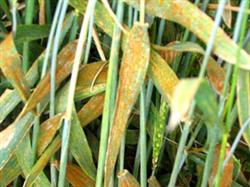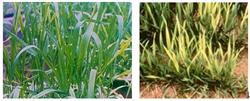What is wheat rust like?

What is wheat rust like? Wheat rust is also called jaundice. There are three kinds of stripe rust, leaf rust and stem rust. It is the most widespread and most harmful disease in wheat. After wheat is infected with rust, there are chlorotic spots on the surface of wheat leaves or straw at the initial stage, and then yellow or reddish-brown pink blisters grow, that is, the germ summer spores pile up, and the powder blisters break and scatter rust-like powder, so it is called rust. In the later stage, there are black blister spots or pink blisters, that is, the germ teliospore pile. The specific symptoms of all kinds of rust are as follows: (1) Stripe rust: it mainly harms leaves and can also occur on leaf sheaths, culms and ears. At first, a chlorotic streak was formed, and then a summer spore pile was gradually formed in the spot. The summer spores are bright yellow and oval. Smaller than stem rust and leaf rust, arranged longitudinally along the veins in the leaves, extremely neat, which is the most typical symptom of the disease. In the later stage, the epidermis slightly ruptured and scattered bright yellow powder, namely summer spores. When wheat is about to mature, dark black, flattened and raised spots are formed on the inside or edge of the summer spore pile, which are not easy to break, that is, the winter spore pile. The stripe rust on wheat leaves at seedling stage had summer spores heaped and did not arrange into strips. At the initial stage, the stripe rust spread around in concentric circles from the original infection point, and then concentrated into pieces. (2) Leaf rust: it mainly occurs on the front of the leaf and can also infect the leaf sheath. The summer spore pile was orange in the early stage, yellowish brown in the later stage, round or oval in shape, irregular scattered in the middle or tip of the leaf, smaller than stem rust and larger than stripe rust, and the epidermis rupture was not significant. After rupture, orange-red summer spores are released. When the wheat matures, the teliospore pile is produced in the place where the summer spore pile was originally produced. Teliospore stacks are generally produced on leaf sheaths and sometimes on the back of leaves; oval or long oval, flattened, dark black, and the epidermis is generally not easy to break. Slight yellowing and withered spots occurred on the leaves of disease-resistant varieties, which did not produce or only produced a very small and dysplastic summer spore pile. At the initial stage, the leaf tissue around the summer spore pile rarely faded, but in the later stage, some or all of the wheat leaves turned yellow and withered. (3) culm rust mainly occurs on the stem and leaf sheath, less on the leaves, and can also occur on the panicle when it is serious. At first, there are reddish brown, long oval or round pustular spots under the epidermis, slightly raised, that is, summer spore pile. Summer spores pile irregular scattered, serious disease can heal each other to synthesize large strip spores pile, and then become rust-brown, epidermis ruptured, and turned outward such as lips, releasing a large number of rust-brown powder, namely summer spores. Disease-resistant varieties sometimes do not produce summer spore piles, but only yellow or brown dead spots. In the later stage of wheat growth, there is an oval or elongated black spot near or in the original part of the summer spore pile, that is, the teliospore pile. After maturity, the epidermis ruptures, revealing black rust powder, that is, teliospores.
- Prev

The method of accelerating germination of Peanut
The method of accelerating germination of Peanut
- Next

Control methods of Wet damage to Wheat
The symptoms of boron deficiency in wheat generally appear first in the new tissue, showing that the terminal bud is easy to die, the flowering duration is long, sometimes tillering while heading, the growth period is prolonged, the stamen is dysplastic, the anther is thin, the empty chaff does not crack, does not disperse the powder, the pollen is few or deformed, the ovary expands transversely, the glume does not close before and after, and wilts in the later stage.
Related
- The first cup of black tea in spring, the flavor and history of tea gardens in Kenya, Africa
- The computer can not only choose potatoes, but also grow tea rice. AI will grow winter oolong tea champion.
- It is not only the inflated tea bitten by insects, but also engraved with the four seasons tea in Beipu.
- The Oriental Beauty Tea Festival in Zhuxian County takes the stage at the weekend to experience the plus-size feast of oil tea.
- & quot; Oriental Beauty Tea & Exploration of Emei in Hsinchu, the hometown of quot;
- The new variety of strawberry "Tainong 1" dessert is the first choice with mellow aroma. Crimson gorgeous
- History of Tea in Taiwan: from Wild Inner Mountain to Export Tea Garden
- Two types of Taiwan Oriental Beauty Black Tea won the British three-Star Award for Childhood Tea Xiang Zhang Jiaqi changed from pilot to champion tea maker.
- Banana species and varieties: the planting history of Taiwan Xianren banana and dwarf banana is long, is banana disease resistant?
- Coffee planting Technology: Qianjie Coffee from Seedling to harvesting

